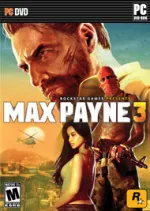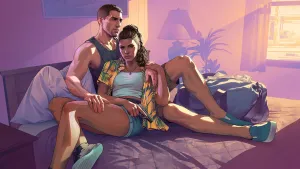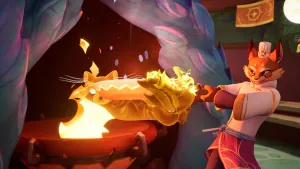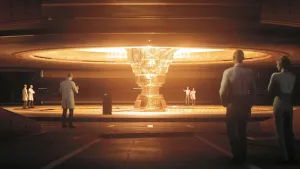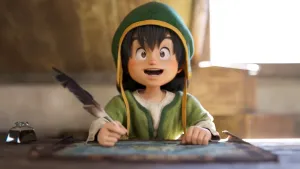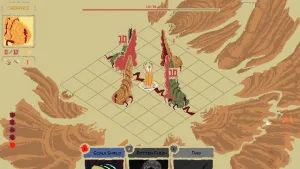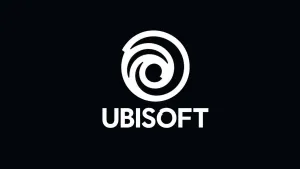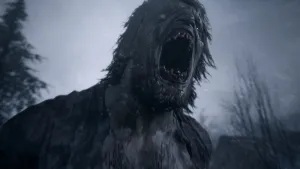Max Payne 3
What does it feel like to lose everything? Most of us will never know. But what would you do if you lost your job? Your true love? Your sanity? Your reasons for living? Rockstar’s long-missing noir hero, Max Payne, knows the answer to these questions.
Max has been absent from the video game landscape since the 2003 release of Max Payne 2: The Fall of Max Payne. The long‑awaited Max Payne 3 features a hero much different from the handsome character we once knew. This new Max is older and harder, marked with the scars of his fall to the bottom. While he’s still very much a violent man of action, the world around him has moved on and so has he. What would a man with nothing left to lose do to get one more chance at the good life? This question will ultimately be answered in Rockstar’s next epic adventure.
The Third Act
If you want to know how much has changed in the world of Max Payne,
look no further than the picture on the top of this page. This bald,
bearded man bears little resemblance to the character we followed
through two successful games. He’s aged considerably since the tragic
events of Max Payne 2, with a scarred face and thicker build. If not
for the headline, it would be hard to recognize Max at all. Clearly,
Rockstar Games, which is developing the game in-house for the first
time since purchasing the rights from series creator Remedy, is not
averse to taking chances with the franchise.
“It’s a tricky
thing, because you’re taking this beloved franchise that we didn’t do
originally,” comments Rockstar art director Rob Nelson. “You have to
maintain the elements of it that are special and that people remember,
but you also have to evolve. We’re not Remedy, but we have a lot of
respect for what they did. We’re definitely looking back and trying to
maintain every element that clicked with people eight or nine years ago
and make it have the same impact now.”
It’s a difficult
balancing act. How do you create a game that both respects the history
of the franchise and creates a world that feels fresh to gamers in
2009?
“We’re used to having franchises that people expect a
lot from and have a lot of pressure attached to them,” Nelson says.
“We’ve learned to go with our gut and trust our instincts….we wanted to
challenge ourselves.”
At Rockstar’s headquarters in New York,
located in the hip SoHo district, we witnessed a world-exclusive first
look at the game in action. If you expected a by-the-numbers sequel,
prepare to be surprised. The third chapter of the Max Payne saga takes
our hero places that he’s never gone before, while at the same time
keeping an eye towards maintaining and improving the stylish gunplay
that made his reputation. Like most Rockstar games, it’s clearly a
labor of love (and just a little bit of mania). 
The Urban Jungle
More than any other publisher,
Rockstar’s games depend on a real sense of place and culture. Whether
it’s Liberty City’s dense metropolis, Bully’s bucolic school campus, or
the arid desert of the upcoming Red Dead Redemption, the main
characters in Rockstar games are often reflective of the setting
itself. The company is known for creating worlds so immersive and
complex they seem as real as our own hometowns – and a good deal more
exciting.
The dark, damp New York setting and atmosphere of
classic film noir marked the first two Max Payne titles, a cinematic
style defined by films like The Maltese Falcon and A Touch of Evil.
Their graphic novel style cutscenes and dark scripts created a sense of
foreboding and drama rare for the day. However, the team at Rockstar
Vancouver is embracing a new, more contemporary setting for its gritty
crime tale: Sao Paulo, Brazil, a sprawling Latin American megalopolis
boasting a population of over 20 million people.
“If you take a
look at films like City of God and Elite Squad – there’s some really
intense situations happening down there,” says Rockstar’s VP of
development Jeronimo Barrera. “The setting is so ripe with things for
us to play off of.”
Sao Paulo’s ghettos, known as favelas in the
native Portuguese, are some of the most dangerous in the world. In
addition to drug trafficking, one of the city’s most notorious gangs,
the Primeiro Comanda da Capital, controls huge swaths of the city and
has organized large-scale prison riots, robberies, and high-profile
kidnappings since its formation in 1993. Combine the city’s notoriously
corrupt police forces with the sobering statistic that one out of every
75 citizens is carrying a gun and it’s little wonder that the number
one cause of death for young people in Sao Paulo is murder.
Sao
Paulo demonstrates all extremes of the human condition, making it a
perfect setting for a Max Payne tale of crime, violence, and
redemption. “You’ll see a high-rise building with a multi-million
dollar penthouse, and at the base is literally shanties,” Barrera
recalls. “Sao Paulo has the greatest number of heliports on top on
buildings of any city in the world. For the rich, it’s safest to travel
by air. There are a lot of private security forces.”
As always,
Rockstar took tremendous strides in researching Sao Paulo. More than 10
staffers traveled to the city to take reference photos, gather
information, and generally soak up what they refer to as the “vibe” of
the city. They even took the unprecedented step of bringing down
equipment to perform 3D scans of locals to make sure their pedestrian
and enemy models were authentic.
“We shipped down all this 3D
scanning equipment, had all sorts of problems with customs,” Nelson
recalls. “We scanned hundreds of people. We worked with a casting
agent. We told them what we wanted and they sent us hundreds and
hundreds of images. The people came in and just brought their own
clothes usually and we scanned them.”
For Barrera, this
attention to detail separates Rockstar’s games from the competition.
“It’s the real deal,” he says. “It’s about bringing all these elements
together – the technology, the research, the storytelling. That’s why
our games feel right and look right. There’s a legitimacy there when
you’re actually working with people in the favelas and you’re down
there and doing the research.”
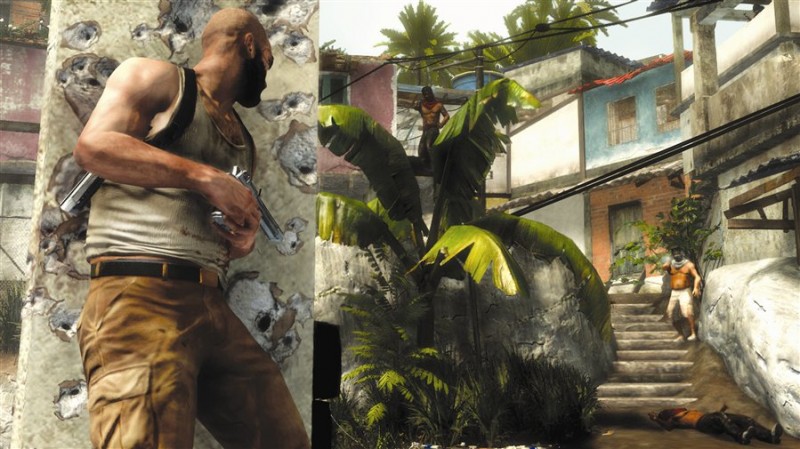
A New Kind of Noir
This
begs the question: What is Max Payne, the embattled former NYPD
detective, doing in Sao Paulo? As with any good noir, the truth is hard
to discern. Rockstar is cagey when it comes to revealing spoilers, but
here’s what we do know.
Haunted by the tragic events of Max
Payne 2, our hero falls into disrepute. Alcoholism and an addiction to
painkillers (an addiction he still battles with, judging by the HUD on
the build of the game we saw) have reduced him to a broken man. Cut
loose from the NYPD, Payne spent the last 12 years of his life in a
frightful downward spiral. In speaking about the game, Rockstar refers
to this time period as Max’s “missing years.” Whether the game reveals
just what happened during this time is unknown, but it’s clear that
this period has taken a tremendous toll on our hero both mentally and
physically.
“Rock bottom” is what alcoholics call the point at
which your life cannot get any worse. Max hits rock bottom in Sao
Paulo, a city he moved to in order to escape from the demons of his
life in New York. Through some somewhat disreputable connections, he’s
taken work in the “private security” sector for one of the city’s
wealthiest families. While on the job he is drawn into the dark
underworld of Sao Paulo and becomes involved in a series of events that
could cost him the last thing he has left: his life.
At first
it’s strange to see this new Max, heavily muscled with a beard and
shaven head, trudging through the labyrinthine alleys of Sao Paulo.
It’s certainly a world away from the rain-soaked streets of New York
City. Still, the team at Rockstar felt the setting of the game is still
true to the noir tenets that helped make the first two games so
memorable.
“Some people say, ‘Max is a noir game and it has to
be black and white and in New York,’” Barrera says. “But noir is a
style not necessarily a place and a color scheme. Noir is not
necessarily saxophones and big dark shadows. It’s looking at a world in
a bleak way. That’s what we’re doing. It’s more contemporary.”
Since
Max is older, the team decided against using voice actor James
McCaffrey again. Instead, they plan on casting a new voice actor who
can better express the toll that the years have taken on the
protagonist. In recent Rockstar fashion, don’t expect a big Hollywood
name, but, as Nelson suggests, “We’re good at [casting].” No matter the
actor, Max’s trademark internal monologues, which Rockstar sees as core
to the franchise, will be in the game. “I can voice over some Max Payne
stuff,” jokes Barrera, intoning in a mock serious voice, “I was
desperate for some bullets, like the desperation of a child.”
For
Rockstar, this new setting transposes much of the franchise’s trademark
grittiness into a fresh new environment. “All the Max Payne themes will
remain intact – manipulation, betrayal, and the stuff that really made
Max Payne,” Nelson claims. “Will there be nighttime levels in the rain?
Probably, but level after level of that stuff would get old, so we
thought it would be interesting to put him in this environment. You
have the very rich living next to the very poor, and that creates a lot
of tension.”
More importantly, the variety and density of Sao
Paulo makes the perfect setting for the varied and intense gameplay.
Watching Max run through a favela shantytown with enemies popping up
from every makeshift doorway or lopsided rooftop, it’s clear that the
levels provide the intrigue and detail necessary for the series’
trademark blazing gunplay.
“The favelas are like little mazes,”
Barrera says. “It’s not like it’s a one-to-one replica, but we went
down there and mapped out different areas. [We] looked at the
structures and how they are built and said, ‘Oh, this would be fun.’
Ultimately, we’re building this stuff so it’s fun in a Max Payne
shooter, so it’s got to have certain elements to make it fun to play. I
don’t think we would set the whole thing in the favelas, either; we
want to give a lot of variety. Every compelling location we could find
in the city we are going to use.”
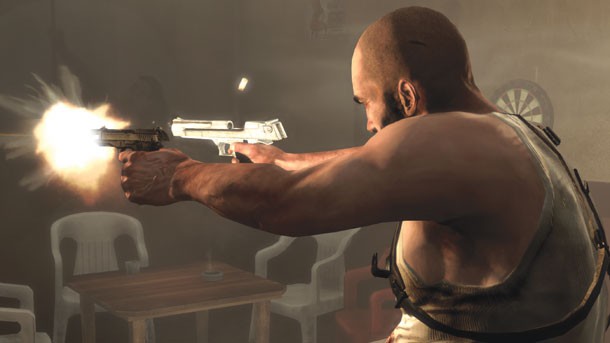
The Way of the Gun
Whatever
the setting, the core of the Max Payne experience rests with the
graceful, slow-motion gunplay that thrilled gamers upon the release of
the first title. The game’s Bullet Time mechanic was an innovative and
addictive addition to the shooter genre, winning the game accolades
from fan and critics alike. However, the feature was so successful that
it now presents a distinct challenge for the team. In the eight years
since the release of the original, slow-motion “focus” modes have
become a standard of the third-person genre, present in literally
dozens of successful games. How can Bullet Time evolve past its
imitators without losing what made it so fun in the first place?
Rockstar Vancouver plans to solve this problem the only way it knows
how: with a near obsessive commitment to making sure that Max Payne 3’s
gameplay feels and looks exactly right.
“We’re going to have Bullet Time because it’s Max Payne,” Barrera
states. ‘The bigger question, since there have been so many clones of
the third-person shooter with Bullet Time, is “How do we get Max back
on the throne?’ For us, it’s a combination of things. We’re going to
have Bullet Time, so it’s going to be slow. Now you’re going to have to
see all the nice little nuances that these machines can do.”
The
team is using the company’s RAGE engine, coupled with the NaturalMotion
Euphoria animation technology that was so successfully utilized in GTA
IV. By blending motion-capture with NaturalMotion’s procedural
animations, the team has created a game that both looks and feels
remarkably realistic. As you watch the game, the attention to detail is
remarkable. If Max jumps sideways towards a crate (which is fully
destructible like many of the objects the environment), you’ll see his
hand reach down to support his weight so he can vault over it. When he
lands, you’ll feel a sensation of Max’s new bulk as he hits the dirt.
The animation system is clearly important to the team. During our
interview, Rob Nelson was on his feet, miming jumps left and right with
two imaginary pistols drawn, at one point crouching behind the couch to
demonstrate the game’s new cover system.
Yes, Max Payne 3 does
feature cover, but Rockstar is quick to point out that its merely
another option for the player, not the focus of the game. “The way that
you experience this world isn’t just ‘Take cover, shoot, and move to
the next piece of cover,’” Nelson says. “We want to make the experience
very detailed. It’s similar to GTA IV. We could have gone bigger, but
it was decided to go with more density. We’re focusing the attention on
every little motion he makes.” Another source of cover comes in the
form of human shields, which you can take at any time. The team is
working hard on this mechanic, making sure that Max can target and move
effectively while taking a hostage.
“We took all the elements of
the traditional Max and expanded it out so the game becomes gun ballet,
or ‘gun-fu’, or whatever you want to call it,” Barrera interjects. “We
have cover in the game but you don’t have to use it. You can approach
the levels however you want to approach them. The AI will have scripts
that run to set-up events, but they also have their own brains, so it’s
a little bit different each time.”
While the core Bullet Time
mechanics are being refined to present an even more fluid gameplay
package, the team is also using slow-motion techniques in new ways,
internally called “Environmental Bullet Time.” Basically these moments
are similar to the quick-time events that occur in many third-person
action games, but with a difference. The player has full control at all
times, and is able to use the slowed down tempo of Bullet Time to pull
off maneuvers that would be too difficult at full speed. One example
Rockstar revealed occurs in the favela. After vaulting over a wall, Max
slides down a tin roof, artfully picking off enemies on each side as he
descends. While Rockstar says most of the game is still primarily
focused on gunplay, Barrera did hint at more “surprises” in store for
players in the form of special set pieces. 
Putting The Pieces Together
While
there’s still much we don’t know about the game, seeing the game in
action made us hopeful that the finished product will live up to both
the standards of the series and Rockstar Games in general. In this more
focused game design, the RAGE engine is capable of a remarkable amount
of detail. Seeing Max walk through a series of shantytown alleys, it’s
clear why Rockstar was so adamant that Sao Paulo was the only place to
tell this new chapter in the saga. The buildings are in various states
of decay. We observe crumbling brick linked together with rusted
aluminum and rotting wood. The precarious structures tower two and
three stories above the street, providing innumerable hiding spots for
the enemies that pop out of every turn. While it’s by no stretch an
open world game, Max does have the ability to climb up and down shorter
walls, which allows you to take alternate routes of attack as in
Rockstar Vancouver’s The Warriors.
As Max dispatches enemies
with arcing slow-motion dives, you notice little details like the
shower of shells ejecting from his weapon and the slow back and forth
of the pistol’s firing mechanism. As we hit a foe a story above us, his
knees buckle on the ledge before he swan dives towards the ground. At
key moments, the game enters into a striking “Bullet Cam” mode, where
the viewing angle whips around and we follow the bullet up close as it
penetrates an enemy’s arm.
After a dive, the game even accounts
for Max’s realistic movement on the ground. Instead of magically
popping up, you can fire with one hand as Max props himself up with the
other, rotating his trunk around to target an enemy on the other side.
This ability to shoot from the ground can be a lifesaver in many cases.
You can actually revive yourself from a kill shot by getting off one
accurate bullet just as the screen fades to black around you. If your
last shot hits your murderer, you’ll receive an adrenaline boost to
survive.
While all the little details help add a sense of place
and realism to the game, the strengths of Max Payne 3 are still those
that helped carry the first two entries to success. It’s a
no-holds-barred shooter that retains a laser-like focus on gunplay. So
far, the game seems to have this crucial element nearly perfected.
“The
first thing was, let’s make the shooting fun and the reactions fun,”
Barrera says. “We wanted that core mechanic to be solid from day one.
You don’t want a shooter where it’s not satisfying. Every gunshot needs
to [feel right] – whether you’re hitting the guy or not. Max
communicates to the world via his weapons, so you want to be able to
have the craziest reactions. You want it to seem like you’re really in
the world. If a guy is running from you and you shoot him in the foot,
you want him to react in the proper way. If you’re shooting a guy with
a machine gun, you want him to get riddled with bullets and shake.”
In
many ways, Max Payne 3 typifies Rockstar’s approach to game making. By
combining ultra-violent action with dark, real world themes, the
developers hope to make a game that’s as compelling as the gritty cult
films that the company draws its inspirations from. Though he’s been
missing in action for years, Max Payne is still very much a part of
Rockstar’s vision for gaming. Despite Max’s weathered appearance and
the story’s exotic locale, Barrera hopes that the game can live up to
the dramatic, visceral thrills of the original games.
“It’s part
of the evolution,” he observes. “In a lot of people’s memories, Max
Payne, at the time it came out, was the nearest thing we had to art in
games. It was technically awesome. It was fun to play. The story was
compelling, and the presentation was above what anyone else was doing.
So we have to work on those core elements. [But] Max has moved on. This
is a new environment and the ongoing tale of his life.”

